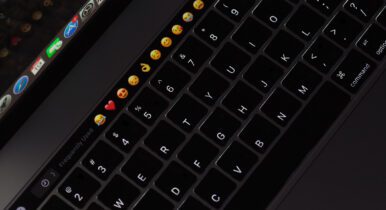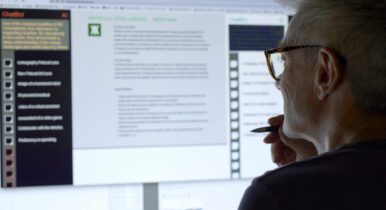Collaboration in Political Design

Image Credit: manonallard
In a way, Megan C. Clark’s design career started while she was completing her political science degree at William & Mary. That’s when her work on a Virginia state legislative race made her fall in love with campaigns. She went on to get her start in the industry at Resonance Campaigns, a Democratic mail shop where she was mentored by the firm’s then-art director.
Resonance’s clients included Hillary Clinton’s presidential in 2016. After the cycle wrapped, she jumped to the Democratic Legislative Campaign Committee (DLCC), which was channeling some of the left’s anti-Trump grassroots energy.
She’s now a senior graphic designer at Aisle 518 Strategies where she works with progressive candidates including Bernie Sanders, Mandela Barnes, and Mark Kelly.
C&E: Is designing for progressive candidates easier now because the aesthetic is so established?
Clark: I definitely feel like it’s a little harder to stand out in the space when everyone is doing gradients — even some Republicans are using the AOC slant. I think progressive designers are kind of at a point now where there’s a lot of similar ideas being recycled. So it’ll be interesting to see over the course of the ’24 presidential cycle what new styles start to break out as people try to establish their own personal brand from the kind of consensus that’s going on right now.
C&E: Is there a current political design trend that you’re following?
Clark: One trend that I really love and played into a little bit when I was at DLCC is campaigns collaborating with artists — especially local artists from their district or their state. I first saw this with the iconic Obama hope poster, and then [in 2016] Hillary released special edition buttons that were designed by famous typographers and designers. That trend has been trickling down the ballot in a way that’s really good and really makes people stand out. For example, right now, Beto is selling a shirt on his website called Shirley’s shirt, and it’s basically a recreation of a handmade shirt that an older woman had worn to one of his rallies.
I saw last cycle that Bernie collaborated with a lot of artists and at the DLCC we worked with an illustrator, Amy White, to illustrate all 50 state capitol buildings, and then used that to create some new merch.
C&E: Are campaigns doing enough to design and create their own unique merch?
Clark: As a designer, there are not many experiences quite as special as seeing somebody wearing the merch you created — especially running into it out in the wild.
For me, personally, I like making merch. It’s one of my favorite things that I’ve worked on in my career. And I think there’s some interesting tech innovation on the printing technology front with vendors where instead of having to order 1,000 T-shirts at once, you can basically pay for them to keep your design on hand, and then when somebody orders the shirt in their size, they print it. I think that’s been a godsend to smaller organizations and campaigns. But you really wanna have something that’s unique.
C&E: What about in the paid space, is there a design tactic that’s working on the left?
Clark: I think one trend that a lot of people have been seeing success with is kind of undesigned graphics — graphics that look like they’re part of the media. For instance, graphics that look like a screenshot of a text message or a screenshot of a tweet. I’m a little afraid we’re working ourselves out of a job with this.
I’m sure things will circle back to extremely designed graphics, but I think people like things that look real and there’s kind of some authenticity that comes from just getting something that looks like it’s a message directly from the candidate that hasn’t been filtered through the comms team and a designer and legal approval — even though those things are all still happening in the background.
C&E: What’s your advice to campaigns that want to ramp up their organic content over the next three months?
Clark: I would say to look outside of politics for some people that could help you out. If you have a college campus [nearby], maybe hiring a paid design intern from their art program? Or just kind of ask around because there are really not a lot of people who are working in political design. The agencies have kind of snapped us all up.
But whenever I’ve been involved in a hiring process, trying to bring on a new junior designer to the organization or whatever, it’s always a struggle to find applicants. So I think if you are in that position, it’s a great opportunity to bring more people into the political design pipeline. The benefit of getting people who have not worked specifically in politics before is that you might get some more fresh ideas. Because in politics, I feel like we have a tendency to just kind of all copy each other all the time.
C&E: Do you feel like design can make a difference in a tight race?
Clark: I definitely see design more coming in on the GOTV side then the persuasion side. I think having a designer’s eye on your campaign can be very critical in making sure that what you’re putting out is accessible.
The designer is always the one telling legal, ‘Hey, can we cut some characters here? Can we make this simpler? Can we shorten this text?’ That makes things easier for people to process and understand. If you’re sending out a mailer and trying to get someone to take away a little bit of your message before they chuck it into the recycling bin, brevity is an important skill that designers are usually honing in on. I think that’s a really important voice to have on your team.
C&E: Do you think the aesthetic of 2022 political design will extend into 2024?
Clark: I think it’s a small world and it’s gonna be the same folks who are designing now who are gonna be snapped up by all the high-profile races next [cycle]. But I think the goals and stakes will be different. Right now, I feel like working on Democratic politics, we are really rolling with the punches a lot of times. We can go one day from designing a graphic about abortion access to the next day, trying to find open-source photos of Mar-a-Lago. I would like to think that when it’s a presidential race, there’ll be a little bit less of responding to the news of the day and people will have a little bit more time and focus to think about who their candidate is and really creating branding that matches that individual and highlights their strengths.



